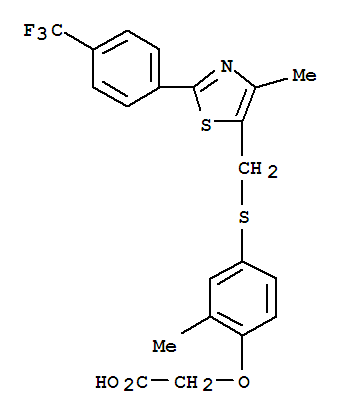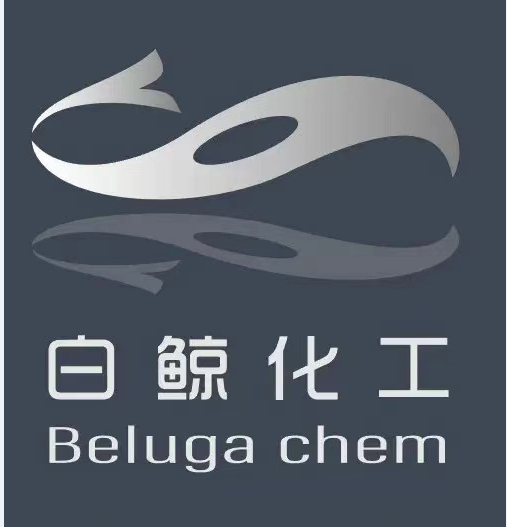
Product Details
|
317318-70-0 Name |
|
|
Name |
GW-501516 |
|
Synonym |
2-[2-methyl-4-[[4-methyl-2-[4-(trifluoromethyl)phenyl]-1,3-thiazol-5-yl]methylsulfanyl]phenoxy]acetic acid;GW 501516, >=98%;ENDUROBOL (GW-501516)/CARDARINE/;Cardarine(GW501516, GSK-516);GW-501615;CB6465728;2-(4-((2-(4-(Trifluoromethyl)phenyl)-4-methylthiazol-5-yl)methylthio)-2-methylphenoxy)acetic a;{2-Methyl-4-[4-Methyl-2-(4-trifluoroMethyl-phenyl)-thiazol-5-ylMethylsulfanyl]-phenoxy}-acetic acid |
|
317318-70-0 Biological Activity |
|
|
Description |
GW 501516 is a PPARδ agonist with an EC50 of 1.1 nM. |
|
Related Catalog |
Signaling Pathways >> Autophagy >> Autophagy Signaling Pathways >> Cell Cycle/DNA Damage >> PPAR Research Areas >> Metabolic Disease |
|
Target |
PPARδ:1.1 nM (EC50) |
|
In Vitro |
GW 501516 is shown to be the most potent and selective PPARα agonists known with an EC50 of 1.1 nM against PPARα and 1000-fold selectivity over the other human subtypes, PPARα and-γ[1]. GW 501516 exerts anti-inflammatory effects in mouse cultured proximal tubular (mProx) cells. GW 501516 inhibits palmitate- and TNFα-induced increases in MCP-1 mRNA expression in a dose-dependent manner[3]. |
|
In Vivo |
GW 501516 causes impaired bone formation, leading to decreased BMD and deterioration of bone properties in OVX rats[2]. GW 501516 attenuates interstitial inflammation and proximal tubular cell damage in a protein-overload mouse nephropathy model[3]. GW 501516 treatment enhances running endurance and the proportion of succinate dehydrogenase (SDH)-positive muscle fibres in both trained and untrained mice[4]. |
|
Cell Assay |
GW 501516 is dissolved in DMSO. Cells are starved by incubation in 0.2% FCS DMEM for 9 h, then pre-incubated with GW 501516, at a final concentration of 2.5 and 5 µM, or 0.05% DMSO as control for 3 hours, followed by stimulation with 150 µM palmitate bound to 8.0% BSA for 12 h[3]. |
|
Animal Admin |
Rats: Female Sprague Dawley rats, 12 weeks of age, are allocated to a sham-operated group and 3 OVX groups; high-dose GW 501516 (OVX-GW5), low-dose GW 501516 (OVX-GW1), and a control group (OVX-CTR), respectively. Animals receive GW 501516 or vehicle (methylcellulose) daily for 4 months by gavage. Bone mineral density (BMD) is assessed by dual x-ray absorptiometry at the femur, spine, and whole body[2]. Mice: Mice are randomly allocated to different groups and receive therapeutic diet and treatment. The GW 501516-containing rodent diet is made by evenly adding GW 501516 to the control diet to a final concentration of 0.04% w/w. In the control diet, 10% of the total calories are from fat (5.5% from soybean oil and 4.5% from lard)[3]. |
|
References |
[1]. Wei ZL, et al. A short and efficient synthesis of the pharmacological research tool GW501516 for the peroxisome proliferator-activated receptor delta. J Org Chem. 2003 Nov 14;68(23):9116-8. [2]. Mosti MP, et al. Effects of the peroxisome proliferator-activated receptor (PPAR)-δ agonist GW 501516 on bone and muscle in ovariectomized rats. Endocrinology. 2014 Jun;155(6):2178-89. [3]. Yang X, et al. GW 501516, a PPARδ agonist, ameliorates tubulointerstitial inflammation in proteinuric kidney disease via inhibition of TAK1-NFκB pathway in mice. PLoS One. 2011;6(9):e25271. [4]. Chen W, et al. A metabolomic study of the PPARδ agonist GW 501516 for enhancing running endurance in Kunming mice. Sci Rep. 2015 May 6;5:9884. [5]. Ji Y, et al. PPARβ/δ Agonist GW501516 Inhibits Tumorigenicity of Undifferentiated Nasopharyngeal Carcinoma in C666-1 Cells by Promoting Apoptosis. Front Pharmacol. 2018 Jun 28;9:648. |
|
317318-70-0 Chemical & Physical Properties |
|
|
Melting point |
134-136°C |
|
Boiling point |
584.5±60.0 °C at 760 mmHg |
|
Density |
1.4±0.1 g/cm3 |
|
Molecular Formula |
C21H18F3NO3S2 |
|
Molecular Weight |
453.498 |
|
Flash Point |
307.3±32.9 °C |
|
PSA |
112.96000 |
|
LogP |
6.29 |
|
Exact Mass |
453.068024 |
|
Vapour Pressure |
0.0±1.7 mmHg at 25°C |
|
Index of Refraction |
1.619 |
|
Storage condition |
Refrigerator |
|
Stability |
Light Sensitive |
|
Water Solubility |
DMSO: soluble20mg/mL, clear |
|
317318-70-0 Description |
|
Peroxisome proliferator-activated receptor δ (PPARδ) stimulation or over-expression in adipocytes leads to increased fatty acid oxidation, improved exercise tolerance, and resistance to obesity. GW 501516 is the first highly selective synthetic PPARδ agonist available. GW 501516 binds to human PPARδ with an IC50 value of 1 nM, and is at least 100-fold selective for PPARδ compared to PPARα and PPARγ. In obese primates, GW 501516 increases high density lipoprotein cholesterol and apolipoprotein A-1 specific reverse cholesterol transport. GW 501516 is therefore a model compound for a new type of obesity therapeutic, as well as a selective pharmacological tool for understanding lipid metabolism. |
|
317318-70-0 Uses |
|
GW501516 has been used to study its effect on mutation-driven colorectal tumorigenesis and tumor invasion using mouse model. |








